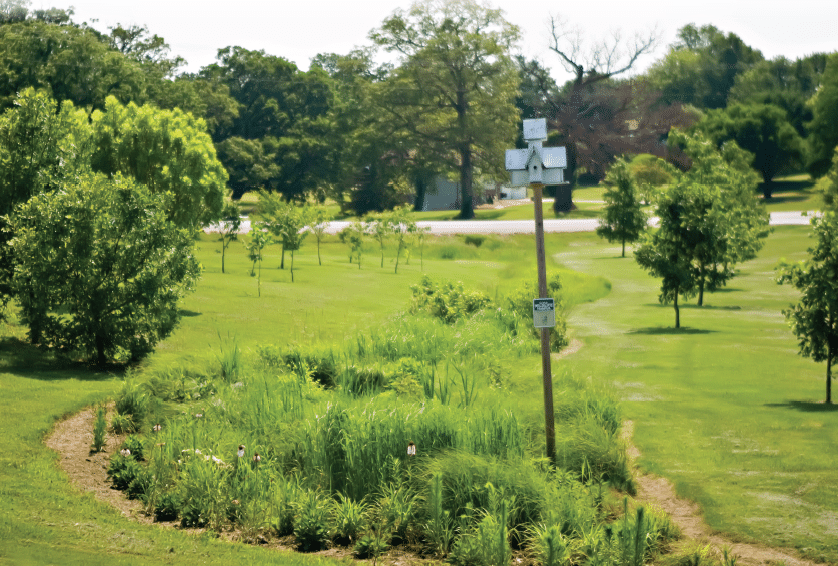Rain gardens serve a vital role in protecting water sources from pollutants during periods of heavy rain. Runoff from excess rain can result in chemicals, oils, fertilizer, and bacteria making their way into local ponds and nearby streams. This phenomenon happens because residential properties include impermeable surfaces such as roofs, driveways, or patios, meaning rain cannot drain efficiently. In fact, the EPA estimates that rainwater runoff accounts for up to 70% of water pollution.
A rain garden is a collection of plants strategically located – usually on a downslope – to absorb the maximum amount of rainwater runoff. The six to twelve inches of soil below your garden should include compost and sand, which increases filtration.
Once rainwater collects in the garden, the filtration process begins. Because these gardens incorporate native vegetation, no fertilizer is necessary after the first year of growing. Therefore, very little maintenance is required to keep your native vegetation thriving once you’ve established your garden.
Five Perennials to Plant in Your Garden
A rain garden is a collection of plants located to help absorb the rainwater runoff. They help protect water sources by filtering pollutants during periods of heavy rain. Runoff from excess rain can carry chemicals, oils, and bacteria into local waterways. Residential properties include impermeable surfaces such as roofs and driveways, or patios. Even lawn fails to absorb much stormwater. In fact, the EPA estimates that rainwater runoff accounts for up to 70% of water pollution.
Once rainwater collects in the garden, the filtration process begins. With the right native plants and some maintenance, rain gardens thrive and provide many benefits.
Consider the rain garden’s site as you choose native plants. For example, is it in sun or shade? Here are five of our favorite species.
Swamp Milkweed
This tall perennial loves moisture. It occurs in swamps, marshes, streams, and creeks. Its fragrant flowers offer nectar that is especially attractive to monarch butterflies.
Blue Cardinal Flower
There’s plenty to love about this native, also called great blue lobelia. It offers stunning, vibrant color and bees, butterflies, and hummingbirds love it. The fact that it’s deer and rabbit resistant is yet another reason to add it to your native rain garden!
Wild Bergamot
With clusters of lavender, pink, or white flowers, this aromatic native is a member of the mint family. It offered medicinal benefits throughout history and is edible. It thrives in a range of soils, making it a low-maintenance part of your native rain garden.
Sweet Coneflower
This easygoing plant can tolerate hot and humid weather. It’s deer resistant and can grow up to three to five feet tall with bright yellow flowers on branched stems.
New England Aster
Deep violet flowers bloom in late summer to early fall (see image). Deer-resistant and loved by pollinators, it’s great for monarchs’ fall migration. This plant can survive in a range of soils but prefers moist, rich soil, making it an optimal choice for a rain garden.
Five Easy Steps to Setting up A Working Rain Garden
1. Determine the square footage of your garden. Divide your home’s square footage by the number of downspouts and then divide by three. This will give you an approximate target size.
2. Calculate the number of plants needed when they’re spaced 18” apart.
3. Lay out your garden on the downslope of your home at least 10 feet away from its foundation.
Dig out three to five inches of soil to remove grass and create a slight depression within its shape. Then, mound soil in a shallow berm on the downside of the garden to increase water retention.
4. Arrange your rain garden plants according to your preference. Place taller species behind shorter ones. Add native grasses or small shrubs if space allows to add structure.
5. Mind these simple maintenance tips. Mulch to prevent weeds during the garden’s first year. Cut back plants in fall while removing dead vegetation.

Rain Gardens and Bioswales
Your Native Plant Experts
Forrest Keeling is more than a native tree nursery. We support ecological growth and environmental sustainability throughout our region and beyond. We continue to learn from nature and use that knowledge for innovation. Together, we’re restoring Earth’s ecosystems one tree at a time.
For more information, get in touch online or give us a call at 800-356-2401 .
